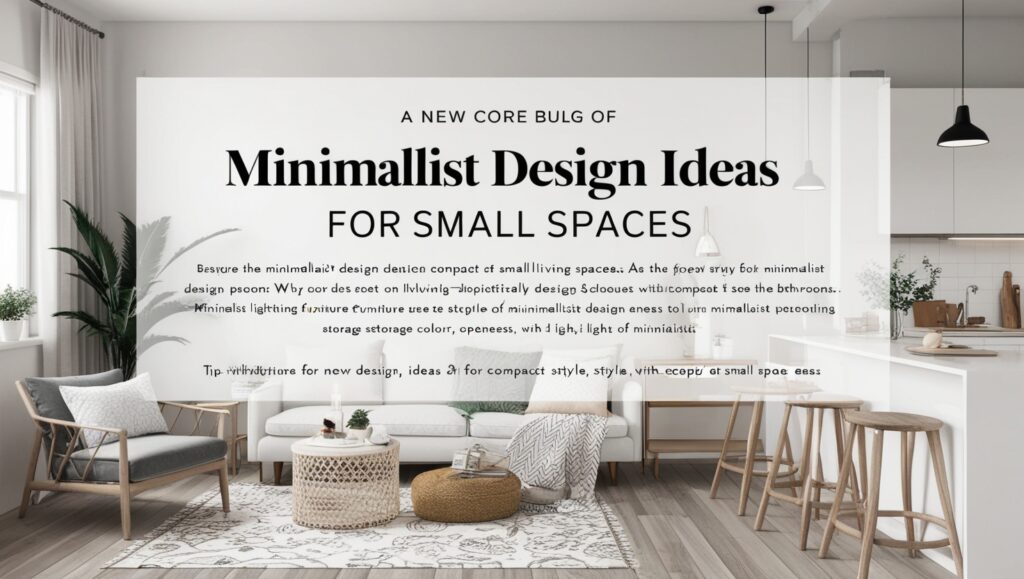Minimalist Design Ideas for Small Spaces
Living in a small space doesn’t mean sacrificing style or functionality. In fact, compact living can often be more efficient and cozy — especially when infused with minimalist design principles. Minimalist Design Ideas for Small Spaces Minimalism is more than just clean lines and monochrome colors; it’s about intentional living — keeping only what adds value and removing everything that doesn’t.
In this blog, we’ll explore practical and elegant minimalist design ideas tailored specifically for small apartments, studios, and compact homes. Minimalist Design Ideas for Small Spaces Whether you’re decluttering a studio or optimizing your cozy flat, these tips will help you create a space that feels open, airy, and totally you.
🌿 What is Minimalist Design?
Minimalist design is centered around the mantra “less is more.” It focuses on:
- Simplicity and functionality
- Neutral color palettes
- Clean lines and open spaces
- Reducing clutter and maximizing utility
- Quality over quantity
In small spaces, this philosophy works wonders by enhancing visual space, improving organization, and creating a sense of calm.
🪑 Minimalist Design Ideas for Small Spaces
1. Choose Multi-Functional Furniture
In a small space, every piece of furniture should work harder for you.
Ideas:
- A bed with built-in storage drawers
- A fold-out desk that doubles as a dining area
- Ottoman with hidden storage
- Wall-mounted folding tables or murphy beds
This not only saves space but also reduces the number of items needed.
2. Stick to a Neutral Color Palette
Light and neutral tones such as white, beige, soft gray, and muted pastels can make a small space feel much larger and more serene. Minimalist Design Ideas for Small Spaces
Tip:
Use a monochromatic color scheme with subtle contrasts in texture — think white walls with a light wood floor or soft linen curtains.
3. Let Natural Light In
Maximize natural light to make your space feel airy and open.
Design Moves:
- Use sheer or light-colored curtains
- Avoid bulky furniture near windows
- Add mirrors to reflect light and visually expand the room
If natural light is limited, go for layered lighting: ceiling lights, wall sconces, and warm-toned floor lamps.
4. Declutter Ruthlessly
Clutter is the enemy of minimalism. In small spaces, it shrinks the visual room and creates stress. Minimalist Design Ideas for Small Spaces
What to do:
- Follow the one-in, one-out rule
- Keep countertops and shelves as clear as possible
- Store seasonal or rarely used items out of sight
Use drawer organizers, under-bed storage, and vertical shelves to make decluttering easier.
5. Invest in Built-In Storage Solutions
Custom built-ins save space and make the most of every inch.
Examples:
- Built-in wardrobes with sliding doors
- Floating shelves that double as décor
- Bench seating with hidden compartments
Even narrow hallways or awkward corners can house vertical storage units or tall bookshelves.
6. Limit Decorative Items — but Make Them Count
Minimalist design doesn’t mean bare walls or sterile spaces. It’s about intentional styling.
Tips:
- Use a few statement pieces like a large wall mirror, abstract artwork, or a stylish lamp
- Incorporate texture through rugs, cushions, or throws in natural fabrics like cotton, wool, or jute
- Add greenery with easy-to-care-for indoor plants like snake plants or pothos
7. Opt for Open Layouts (If Possible)
If your space allows, remove unnecessary partitions or doors to open up the area. Use rugs or furniture placement to define zones (like a reading nook or dining corner) without crowding the space.
8. Keep Your Floor Visible
Choose furniture with raised legs to keep the floor visible. This gives the illusion of more space and helps the room breathe.
Avoid bulky sofas or floor-hugging storage pieces unless they provide significant utility.
9. Incorporate Mirrors and Glass
Mirrors amplify natural light and add depth to small rooms. Glass-top tables, acrylic chairs, or transparent shelving also help maintain visual openness.
10. Digital Minimalism Counts Too
Cable clutter, chargers, and digital devices can create visual noise. Use cable organizers, go wireless where possible, and keep tech tucked away when not in use.
🏡 Bonus: Minimalist Design by Room
🛏️ Bedroom
- Platform bed with under-storage
- Two-tone palette (white + warm wood or muted gray)
- No more than 2–3 decorative items on surfaces
🍽️ Kitchen
- Open shelving for frequently used items
- Closed cabinets for appliances
- Magnetic strips or wall hooks for utensils
🛋️ Living Room
- Low-profile sofa
- One coffee table or nesting tables
- Wall-mounted TV or slim media console
🚿 Bathroom
- Floating vanity
- Wall-mounted shelves
- Minimal décor (think a candle and one plant)
Final Thoughts
Small spaces can be transformed into stylish, functional, and peaceful retreats with minimalist design. It’s not about giving up comfort — it’s about choosing what truly adds value and letting go of the rest. With thoughtful design and a less-is-more mindset, your small home can feel more spacious, organized, and refreshing than ever.
Minimalism isn’t just a style — it’s a lifestyle. And in small spaces, it’s the smartest choice you can make.

